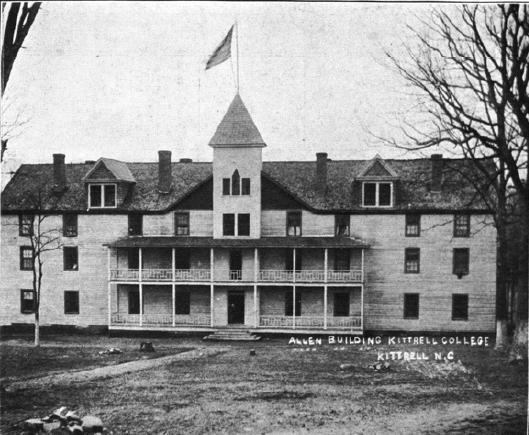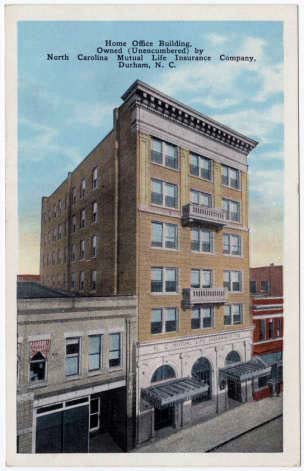Black American History and Culture: North Carolina 1870-1920
By Elizabeth A. Fenn, Peter H. Wood, Harry L. Watson, Thomas H. Clayton, Sydney Nathans, Thomas C. Parramore, and Jean B. Anderson; Maps by Mark Anderson Moore. Edited by Joe A. Mobley. From The Way We Lived in North Carolina, 2003. Published by the North Carolina Office of Research and History in association with the University of North Carolina Press. Republished in NCpedia by permission. Revised December 2022 by NC Digital Heritage Library.
See also: The Quest for Progress main page; The Way We Lived in North Carolina: Introduction; Part II: An Independent People, North Carolina, 1770-1820; Part III: Close to the Land, North Carolina, 1820-1870; Part V: Express Lanes and Country Roads, North Carolina 1920-2001
Independence Halls
From its birth in a brush arbor in Durham in 1869, St. Joseph's AME Church has become one of the leading congregations of that denomination in North Carolina. Its first minister, the Reverend Edian Markham, had been born enslaved in 1824 and had escaped bondage by the Underground Railroad. He educated himself in New York and then chose Durham as his first missionary field. The congregation that he formed was first called Union Bethel.
 Were it still standing today, the two-story wooden building of the AME Church in Raleigh might be regarded as the Independence Hall of black North Carolinians. In this modest structure, located on a back street just a few blocks from the old State Capitol, black delegates from all over the state declared themselves a "Convention of Freedmen" on 29 September 1865. The 115 men, most enslaved just months before, met to find ways to eradicate the legal inequities of the past. They timed their convention to coincide with the assembly of whites who convened blocks away in the state legislative chamber to form a new civil government. For four days they deliberated in the sparsely furnished church, its floor and gallery filled to capacity by 400 delegates, spectators, and reporters. Ever on view behind the pulpit was a lifelike bust of Abraham Lincoln, shrouded in mourning, with the inscription overhead: "With malice toward none, with charity for all, with firmness in the right."
Were it still standing today, the two-story wooden building of the AME Church in Raleigh might be regarded as the Independence Hall of black North Carolinians. In this modest structure, located on a back street just a few blocks from the old State Capitol, black delegates from all over the state declared themselves a "Convention of Freedmen" on 29 September 1865. The 115 men, most enslaved just months before, met to find ways to eradicate the legal inequities of the past. They timed their convention to coincide with the assembly of whites who convened blocks away in the state legislative chamber to form a new civil government. For four days they deliberated in the sparsely furnished church, its floor and gallery filled to capacity by 400 delegates, spectators, and reporters. Ever on view behind the pulpit was a lifelike bust of Abraham Lincoln, shrouded in mourning, with the inscription overhead: "With malice toward none, with charity for all, with firmness in the right."
Colleges for Uplift
The philosophy of uplift and a commitment to black self-help took firm root in nearly a dozen black colleges founded in North Carolina after the war. Handsome buildings named for out-of-state benefactors still grace the campuses of Shaw University in Raleigh, Johnson C. Smith University in Charlotte, and Livingstone College in Salisbury. Each of the schools started in small frame or log buildings, and each began with the mission of training young people to become "Christian workers" and educated ministers who could combat the "spirit preachers" of the day.
Two of the schools received their only early support from northern churches and the Freedmen's Bureau and faced serious opposition from native whites. The Reverend Henry Martin Tupper, the Massachusetts Baptist minister who founded Shaw in Raleigh, was threatened by the Ku Klux Klan in the 1860s. Continuing tension and ostracism in the mid-1870s produced teachers who were, in the eyes of one outside observer, the "most forbidding New England type—with whom duty—in all matters—is always a business and never a pleasure." Yet, "the truth is that a less cold & determined set of people would be badgered almost to death & driven away." The first years of the "Freedman's College" in Charlotte—which would become the Biddle Memorial Institute and finally Johnson C. Smith University—were no less trying for the native white ministers who founded the Presbyterian school in 1867. Fellow churchmen forced the ministers to disaffiliate themselves and the school from the southern church. By the time the African Methodist Episcopal Church established Livingstone College in Salisbury in the 1880s, however, white North Carolinians saw the merit of colleges designed to educate black clergy and instruct black youths in both the liberal arts and industrial skills.
Black Business and W hite Supremacy
hite Supremacy
The North Carolina Mutual Life Insurance Company Building, which dominates the south side of Parrish Street in downtown Durham—and its gleaming twelve-story successor, a daring architectural pillar of glass and concrete built on the hill that once accommodated the estate of the son of Washington Duke—stand as testimony to black achievement amid adversity. A thousand guests attended the dedication of the Parrish Street office structure in 1921 and celebrated the opening of the building as a monument to "Negro progress."
To a black Durham tobacco worker, the Mutual Building and the black Mechanics and Farmers Bank housed on its first floor were more than symbols. A Mutual insurance policy provided a measure of family protection, and the black bank offered the enterprising man a way to get ahead.
In the broadest sense, the Mutual was descended from a century-old tradition of black fraternal and burial societies, built around the ideas of self-help and moral improvement and organized to provide sickness and burial insurance. With the end of Reconstruction and the waning of the quest for black advancement through civil rights and integration, black self-help and benefit societies mushroomed.
In a fundamental way, the Mutual was founded in response to the reign of terror visited upon North Carolina's blacks during the successful white supremacy campaign of the 1890s. It was in October of 1898, the first year of the terror, that John Merrick of Durham—a black entrepreneur wh owned three white and three black barbershops and who served as the personal barber to Washington Duke—gathered together six other men in skilled trades and professions to lay the basis for the company. In the red-shirted vigilantes who broke up black political rallies and threatened violence to blacks who came to the polls, in the gruesome lynching of a black man between Durham and Chapel Hill, they had seen the handwriting on the wall. Though five of the Mutual's founders had been active in the Republican Party, they concluded that October evening that they must abandon politics and the assertion of their rights. Blacks must instead turn to "education, business and industrial progress," "keep quiet and saw wood," and turn their "attention to making money." In "commercial opportunity" they would "hammer away. The almighty dollar is the magic wand that knocks the bottom out of race prejudice and all the humbugs that fatten on it."
Keep reading >> The New Leisure: North Carolina 1870-1920 
Read more about Black American History in North Carolina from 1870-1920 in NCpedia:
North Carolina's Historically Black Colleges and Universities
Black Wall Street, Durham, North Carolina
Mechanics and Farmers Bank
North Carolina Mutual Life Insurance Comany
John Merrick
C.C. Spaulding
Black American History Collection in NCpedia
Black American Biographies
Fenn, Elizabeth Anne, and Joe A. Mobley. 2003. The way we lived in North Carolina. Chapel Hill, NC [u.a.]: Published in association with the Office of Archives and History, North Carolina Dept. of Cultural Resources, by the University of North Carolina Press. Originally published as, From Jubilee to Jim Crow.
Image Credit:
Kittrell College: An Era of Progress and Promise, 1908-1912. Image courtesy of State Library of North Carolina. Available from http://www.historypin.com/attach/uid6161026/map/#!/geo:36.224525,-78.443009/zoom:15/dialog:6862025/tab:details/ (accessed November 5, 2012).
"Home Office Building, Owned (Unencumbered) by North Carolina Mutual Life Insurance Company, Durham, N.C." in North Carolina Postcard Collection (P052), North Carolina Collection Photographic Archives, Wilson Library, UNC-Chapel Hill. https://dc.lib.unc.edu/cdm/ref/collection/nc_post/id/9897
28 March 2019 | Anderson, Jean B.